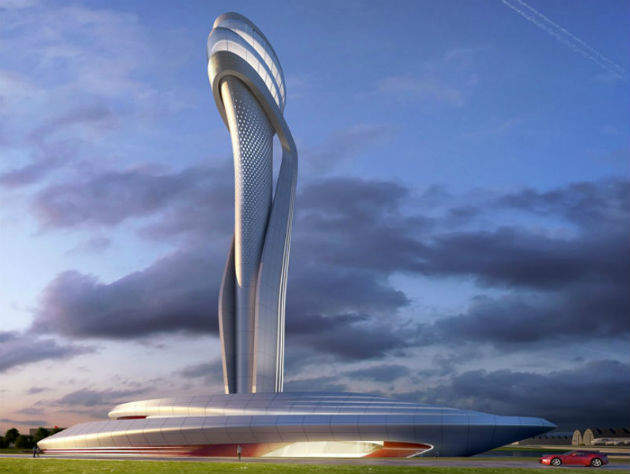

Rising 311ft (95m) into the sky, the first thing passengers will see of the city when they touch down at Istanbul New Airport – scheduled to open in 2018 – is a giant air traffic control tower shaped like a tulip. With steel curves that wrap around a central tower, the design – from Italian transport studio Pininfarina – is so sleek and aerodynamic-looking you’d be forgiven for thinking it might just set off down the runway and fly away.
Those familiar with Pininfarina – famous for designing Italian cars – will know it is not something the studio is particularly used to doing. Last month though, “Ferrari's go-to design company” managed to beat off entries from Zaha Hadid, Massimiliano Fuksas and Moshe Safdie to win the 2016 International Architecture Award.
Engineer and designer Paolo Pininfarina, speaking to Design & Build Review by phone from his base in Italy, couldn't sound much happier. “It was a very high level of competition and we won,” he says emphatically. “It makes me very proud because it is a new business for us, we only started doing architecture five years ago. So this is a very important accomplishment.”
From cars to architectural icons
For Pininfarina, the presence of big, established practices on both the award shortlist and in Istanbul Grand Airport’s (IGA) original competition was part of what drove the project's success.
“When you are in competition with some of the world's top architects you have to do something that has a strong personality, that really stands out,” he says. “Sometimes you will lose because the jury doesn't like it, but sometimes you will win. You don't get anywhere from being conservative when you have competitors like Studio International who do these kinds of competitions all of the time.”
It’s certainly fair to say the renderings don’t look like your average air traffic control tower. Whether it’s a small-scale airport or one of the world's busiest like Heathrow, Chicago or Charles de Gaulle, control towers tend to be drab, dated, purely functional buildings, not considered worthy of good design, let alone “icon” status.
“It's a new idea, a novelty” says Pininfarina. “An air traffic tower like this has never been done before with such a strong design input and content.
“It is made with two different bodies embracing one another and a central part which provides a very organic platform for the upper floor. It's very special because it could be done on a small-scale but this is a tower that is almost 100m high.”
Istanbul New Airport: 'The biggest airport in the world'
When it opens, Pininfarina’s design will be the centrepiece of Istanbul New Airport, which is currently under construction in Arnavutköy district on the European side of the city. The first of four phases ends in 2018, and will see the world’s largest terminal under a single roof with a floor area of almost 11 million square feet and a capacity of 90 million passengers per year.
When the final stage is over in 2028, it will serve 350 destinations using six runways for an annual clientele of up to 200 million passengers. For Pininfarina, that’s some pressure.
“There may be growth in other airports but on today's numbers it should be the biggest airport in the world in terms of the number of people passing through it,’ he says. “Turkey is a country that is part in Europe and part in Asia, and this will be a hub between the two. They want to show the importance of their country and the importance of their place in the world.
“Since the airport will be a hub is it possible that people coming to the airport won’t even see the city. They’ll just stop here and see this tower, which becomes their memory of Turkey and will give them the impression of a city that wants to be in the future.”
While the tower’s design comes from Pininfarina’s creativity, according to the designer it was a collaboration with the US engineering firm AECOM that made it possible. “I was afraid because sometimes when you deal with an office that has such expertise in the sector and you come with new ideas. they don't always like or understand it,” he says. “But this collaboration worked very well because they understood and left us free to create.”
It’s a message AECOM’s head of architecture Jennifer Dixon certainly agrees with: “In this competition our aim was to combine the dynamism and romance of Pininfarina’s architectural style that is so influenced by automotive design with AECOM’s in-house aviation architecture capabilities,” she said.
“The AECOM and Pininfarina team has created a beautiful and highly functional piece that rekindles the excitement and glamour of modern air travel at the crossroads of Europe and Asia.”
Building for a better future
While the result of the collaboration is a piece of architecture that could, in many ways, belong anywhere in the world – “It works in Istanbul as it could in Shanghai,” Pininfarina says – it also incorporates elements of Turkish culture and has a wider message for what the region, which is currently ravaged by conflict, could aspire towards.
“Firstly we wanted to take some element of Turkish tradition,” Pininfarina says. “So we used a tulip – the national flower of Turkey – which is a symbol of spring, life and peace, all things that unfortunately are not very present in the world and especially not near Turkey.
“I thought it was a good idea to take inspiration from a flower, to design something that hopes the future will be better in those countries that are now going through very bad experiences.”


